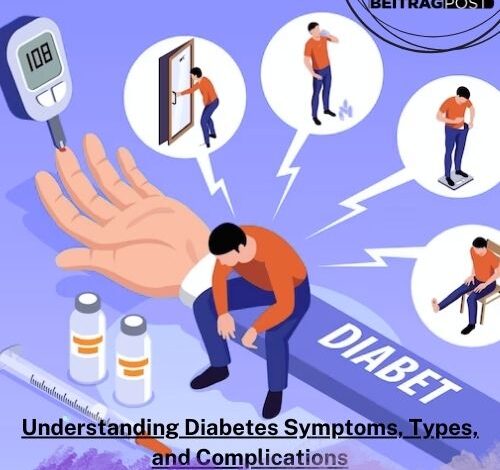Understanding Diabetes Symptoms, Types, and Complications

What is Diabetes and its Common Symptoms?
Diabetes is a condition that impacts how your body handles blood sugar, also known as glucose. It’s crucial to be aware of its symptoms for early identification and management. Let’s explore what diabetes is and its common symptoms, with a focus on symptoms.
Understanding Diabetes
Diabetes arises when your body faces challenges in either producing or properly using insulin. Insulin, a hormone produced by the pancreas, helps regulate blood sugar levels. There are two primary types of it: type 1 and type 2.
Type 1 and 2 Diabetes
This type often begins in childhood or adolescence. It occurs when the immune system mistakenly attacks and destroys insulin-producing cells in the pancreas. Without enough insulin, glucose accumulates in the bloodstream, resulting in high blood sugar levels.
More prevalent in adults, type 2 diabetes emerges when the body becomes resistant to insulin or doesn’t produce enough of it. This leads to elevated blood sugar levels and various health complications if left untreated.
Common Diabetes Symptoms
Frequent Urination
One of the classic signs of diabetes Symptoms is the need to urinate more frequently than usual. This occurs because the kidneys work overtime to filter excess sugar from the blood, causing increased urine production.
Excessive Thirst
Due to frequent urination, individuals with diabetes often experience intense thirst as their bodies attempt to replace lost fluids.
Unexplained Weight Loss
Despite consuming more food than usual, some people with this disease may undergo unexplained weight loss. This happens because the body can’t effectively utilize glucose for energy, prompting it to break down fat and muscle tissues.
Fatigue
Diabetes can lead to feelings of fatigue and weakness due to the body’s inability to convert glucose into energy efficiently. Additionally, high blood sugar levels can disrupt sleep patterns, resulting in daytime tiredness.
Exploring Diabetic Insipidus: A Lesser-Known Condition
Diabetes Insipidus is a lesser-known condition that affects the body’s ability to regulate fluid balance. Unlike diabetes mellitus, which involves blood sugar regulation, DI primarily affects the balance of water within the body. Let’s delve into this condition and understand its causes, symptoms, and treatment options.
Understanding Diabetes Insipidus
DI is characterized by excessive thirst and urination, similar to mellitus. However, the underlying causes and mechanisms are different. DI occurs when the kidneys are unable to conserve water, leading to the excretion of large amounts of diluted urine.
Causes of DI
There are two main types of DI: central DI and nephrogenic DI. Central DI occurs when the hypothalamus or pituitary gland fails to produce or release adequate amounts of vasopressin, a hormone that helps regulate water balance. Nephrogenic DI occurs when the kidneys fail to respond to vasopressin properly, leading to excessive urine production.
Symptoms of DI
Excessive Urination
One of the hallmark symptoms of DI is the production of large volumes of urine, even if fluid intake is minimal.
Intense Thirst
Due to excessive urination, individuals with DI often experience extreme thirst as their bodies attempt to replace lost fluids.
Dehydration
If left untreated, DI can lead to dehydration, which may cause symptoms such as dry mouth, dizziness, and fatigue.
Electrolyte Imbalance
Excessive urination can disrupt the balance of electrolytes in the body, leading to complications such as electrolyte imbalances and muscle weakness.
Treatment of DI
The treatment of DI depends on the underlying cause. Central DI is often managed with synthetic vasopressin analogs, which help replace the missing hormone. Nephrogenic DI may require medications to improve kidney responsiveness to vasopressin or dietary adjustments to manage symptoms.
Understanding Diabetic Ketoacidosis: A Serious Complication of Diabetes
Diabetic Ketoacidosis (DKA) is a severe complication that can arise in individuals with diabetes. It’s crucial to recognize the symptoms and seek prompt medical attention to prevent life-threatening consequences. Let’s explore what DKA is and how it affects those with it.
Understanding Diabetic Ketoacidosis
DKA occurs when the body produces high levels of blood acids called ketones. This typically happens when there’s not enough insulin available to process glucose for energy, so the body starts breaking down fat for fuel instead. DKA most commonly affects individuals with type 1 diabetes but can also occur in those with type 2 under certain circumstances.
Key Features of DKA
High Blood Sugar Levels
One of the primary characteristics of DKA is significantly elevated blood sugar levels, usually above 250 milligrams per deciliter (mg/dL). This occurs due to a lack of insulin, which prevents glucose from entering cells for energy, leading to increased blood sugar levels.
Ketone Production
As the body breaks down fat for energy, it produces ketones, acidic chemicals that accumulate in the blood and urine. High levels of ketones can lead to ketoacidosis, a condition characterized by acidic blood pH levels.
Symptoms of DKA
Common symptoms of DKA include excessive thirst, frequent urination, nausea, vomiting, abdominal pain, fruity-scented breath, confusion, and difficulty breathing. Without prompt treatment, DKA can progress to more severe complications, such as coma or death.
Emergency Treatment
DKA is a medical emergency that requires immediate intervention. Treatment typically involves administering insulin to lower blood sugar levels, fluids to rehydrate the body and correct electrolyte imbalances, and close monitoring of vital signs and blood glucose levels.




